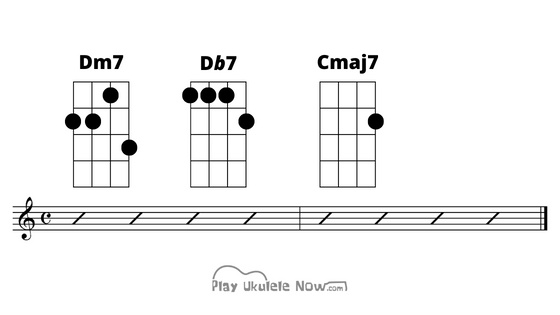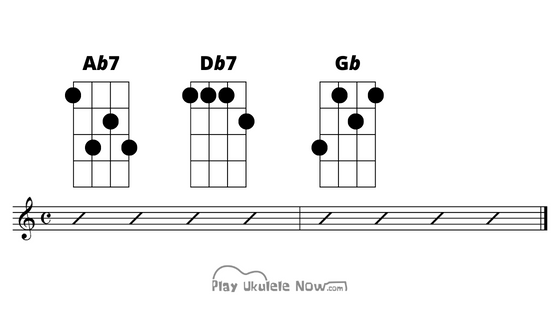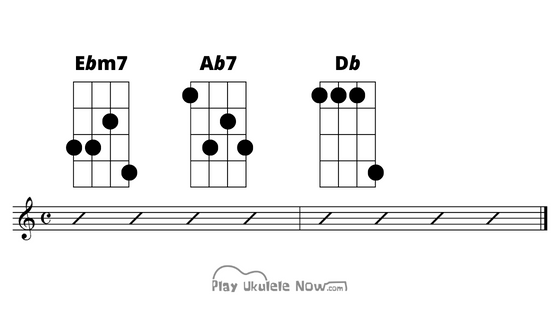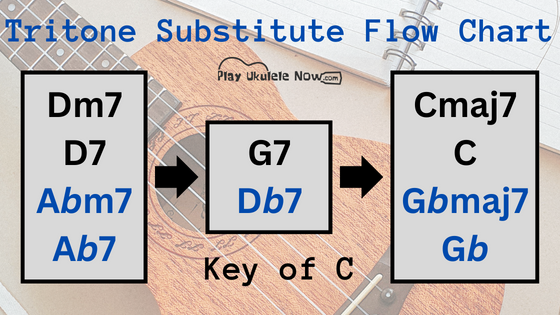you'll knock their socks off with this - use it in any song!
You will Learn More and Play More with Play Ukulele NOW.
Find out for yourself why teachers and students have depended on Play Ukulele NOW Methods and Songbooks since 2009
Find out for yourself why teachers and students have depended on Play Ukulele NOW Methods and Songbooks since 2009
DISCLOSURE: THIS POST MAY CONTAIN AFFILIATE LINKS, MEANING I GET A COMMISSION IF YOU DECIDE TO MAKE A PURCHASE THROUGH MY LINKS, AT NO COST TO YOU. PLEASE READ MY DISCLOSURE FOR MORE INFO.
Find all my chord related posts here: Chord Tips and Tricks
The tritone substitution is very common in jazz (doesn't mean you can't use it in any other style of music - you should because it sounds awesome). This is a great one when you want a little different flavor (sound) than a typical substitute.
It creates a chromatic resolution to the tonic (I) chord when used as the V chord but it can be used for any chord - it is most commonly used as a V chord substitute.
WATCH THIS FUN VIDEO (added 10/25/2024):
The uke I'm using:
What is it? And how to find it...
Typically a tritone substitute is a dominant 7 with the root note a b5 above the root note of the original chord, which is most often the V7 chord - but could be any chord.
Here we look at the most common ways to use the tritone substitute so you can get things rolling right away with it.
Ways to find it
There are a few ways to find it, I'll also include a handy chart for you here.
Find the b5 of the chord your playing and build a dominant 7 on that note: Let's say we're in the key of C major and our progression is a ii - V - I (Dmin7 - G7 - Cmaj7) and we want a tritone substitute for the V7 chord (which is the G7), the b5 of the G7 chord is Db - the 5th of G is D and we need to flat it; lower it by 1/2 step to Db. New progression: Dm7 - Db7 - Cmaj7
Replace the V chord with the bii: If we're in the key of C major and our progression is a ii - V - I (Dmin7 - G7 - Cmaj7) we simply replace the V chord with the bii - the ii chord is D and we flatten it - then build a dominant 7 chord on the Db. New progression: Dm7 - Db7 - Cmaj7
3 whole steps is the tritone interval (that's where the name comes from) so the root note of the Db7 chord is 3 whole steps above the Root note of the G7 chord...
That gives you a few ways to find it on the fly.
Tritone sub's for V7 and ii7
Here's a handy chart with the tritone subs for the ii7 and the V7:
The chart shows ii - V - I's in all keys with the possible tritone subs in parenthesis
Let's try some (Dominant and Major to start with)
First - grab my chord charts - all the chords we look at here can be found there, and make sure you have my charts on all scales harmonized with chords.
ii - V - i's with a tritone sub for the V
Let's look at and listen to the one we've been talking about the ii - V - I in C with the Db for the V chord:
Notice the 7th and the 3rd from the G chord are still in the new chord (the Db7) but flip flopped!
Note: The Db7 is the same chord as the G7b5b9.
Check it out in G - the original progression would be Am7 - D7 - Gmaj7, here it is with an Ab7 for the V chord:
Mmm... Great flavor!Some rules to remember
The first step is to use these for the V chord and to use a dominant 7, here are some things to consider for more advanced players:
RULES TO REMEMBER:
- Any dominant chord can be an expanded of altered, or any combination thereof - more than 60 possibilities there!
- Any dominant chord may be subbed with a dominant a tritone away.
The chart above shows just subs for the V chord - try this ii - V - I in a few different keys and sub one of the chords above for the V.
ii - V - I's with a tritone sub for ii and V
Now we'll sub the ii as well - here it is in C:
And in G:
Ever wished there was an easier way to make the E chord, or the D chord? Are you wondering if there's a way to avoid or simplify barre chords?
There is! This book will solve all of your chord problems...
Any chord can be simplified - in this book I walk you through how to do it with many tricks that the pros know and use all the time!
Get your paperback on Amazon: Ukulele Chord Tricks - Simplify Any Chord (this leads to the book on amazon and you can preview quite a few pages to check it out)
While were at it - what about that Gmaj7?
Tritone subs for the I chord
We don't want that Gmaj7 to feel left out - It can join the party, here's how...
For now (as with everything there are many possibilities - what I present here are starting points) we'll say the I chord can be subbed for a major 7 or a major chord a tritone away. Cmaj7 = Gbmaj7 or Gb.
Play this and you'll knock the socks right off their feet - this ones in C:
Wow!
This one is in G:
Keep this in mind: You may want to use just one tritone substitute somewhere (any of the ones we've talked about), you may want to put something in one part of the song and not another etc...
Since I'm using lots of them for the propose of examples I don't want you to think you have to change everything to a tritone sub...
In the progression we've been working on (Dm7 - G7 - Cmaj7), any 1, any 2 or all 3 of these chords may be subbed with a tritone.
How about some minor 7 tritone subs?
This might be a little off the beaten path - but these sound great!
As we know in a harmonized scale the ii chord is a minor chord, so you may use a minor 7 tritone sub if you like.
Take a look - just the minor 7 here - key of C:
What's next??
It's your turn now - start with making some of your own progressions; ii - V - I's to start with.
First: (a note for more advanced players) It's important to understand (since we used a dominant Sub for the ii chord - which is a minor chord in a harmonized scale) that using a dominant for the ii is a very common substitution.
I'm talking about this progression: D7 - G7 - Cmaj7. As you can see we used a dominant (D7) for the ii rather then the Dm7 that you would expect. This can be done by way of a borrowing the D7 from the Lydian mode or using it as the secondary dominant of the G7. We'll talk more about these kind of things later.
This is why I've included it in the charts that follow...
Tritone Sub flow charts
With these charts you can create many beautiful progressions using what you've learned today - it's all there.
look at it these as menus - take pick a chord from the left, then one from the middle and lastly one from the right. Strum each chord slowly and listen to the chord progression you've created.
Then play your new progression in more of an upbeat manner.
Tritone Sub chart - C:
Tritone sub chart - G:
Now the fun really starts - Do this with other chord progressions. You should have the tools now to do so...
Most popular choices - in case you're wondering (most common cadences):
- D7 - G7 - C
- Dm7 - G7 - C
- D7 - Db7 - C
- Abm7 - Db7 - C
Make your own charts (like the ones above) in other keys that you use and with other chord progressions you use.
Related video (short):
Want more?
Check out my chord related books below. Create beautiful chord progressions in any key and learn to simplify any chord.
Secrets of the Chord Chain: Major and Minor Chord Progressions for the Ukulele
I wish I had books like this when I started playing!
Would have saved me years of frustration.
The great new is you can have them now—In the books I unlock the mysteries of great chord progressions for you and make it so simple to understand that you will be able to create beautiful music right away!
Everything you need to play stunning chord progressions in any key and to fully understand how chord progressions are created and where they come from is here.
Links leads to the books on amazon...
Secrets of the Chord Chain Complete - Major and Minor Chord Progressions for the Ukulele (SAVE WHEN YOU BUY THE COMPLETE EDITION - Books 1 & 2 - 130 pages!)
Ukulele Chord Tricks: Simplify Any Chord
There is! This book will solve all of your chord problems...
Any chord can be simplified - in this book I walk you through how to do it with many tricks that the pros know and use all the time!
Get your paperback on Amazon: Ukulele Chord Tricks - Simplify Any Chord (this leads to the book on amazon and you can preview quite a few pages to check it out)
Get the eBook (instant download): Ukulele Chord Tricks: Simplify Any Chord
Get just one chapter: E Chord and Progression Tricks; E Minor Chord and Progression Tricks; two chapters (they go together): Triads & Accompaniment Patterns Some of these are available FREE to patreon members.
FREE PDF's - Chord book and all scales harmonized with chords (with related articles):
Pin me! your ukulele friends will love you for it...


.png)


.png)
.png)










.png)
.png)






No comments:
Post a Comment